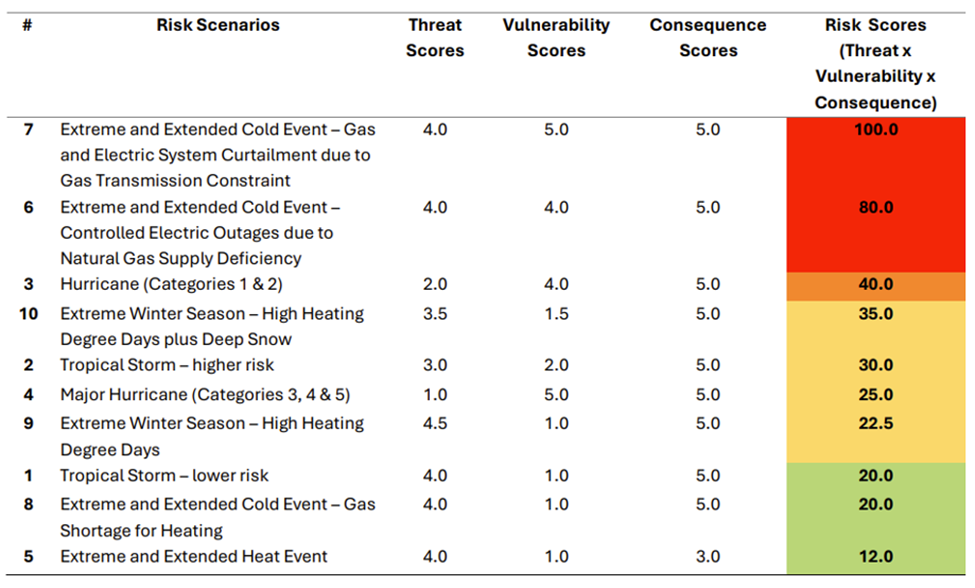Energy Risk Assessment Aids Utility Resilience Planning in Connecticut
As part of our series on the Era of Risk, we highlight another example where risk modeling has taken on a new level of importance – at the state level. State-level risk modeling and planning provides a holistic assessment of the multitude of hazards faced by energy systems. And it facilitates coordination between emergency management personnel and utilities. State-level energy systems planning provides the foundation from which energy system investment priorities and utility resilience plans emerge.
Over the summer of 2024, Synapse helped the Connecticut Department of Energy and Environmental Protection (DEEP) update the energy risk assessment chapter of Connecticut’s 2024 State Energy Security Plan. The starting point of our engagement was U.S. Department of Energy (DOE) guidance. In April 2024, DOE published a guidebook to establish a high-level framework for state risk assessments, which are detailed in State Energy Security Plans (SESP).
DOE’s guidebook recommendations for states include the following:
- Characterize a series of risk scenarios and identify a primary energy system that is impacted for each (electricity, natural gas, or delivered fuels).
- Evaluate the risk for each scenario by scoring three dimensions of risk, including threat (annual probability of occurrence), vulnerability (duration of the impacts), and consequence (customers impacted).
- Multiply the scores from the three dimensions together to develop a composite risk score for each scenario.
- Develop risk mitigation strategies that address the scenarios with the highest risk scores.

Source: Based on U.S. DOE CESER. (2024). Risk Assessment Essentials for State Energy Security Plans. Exhibit 2: Exhibit 2. Risk Assessment Formula and Key Definitions. Page 6. Available at: https://www.energy.gov/sites/default/files/2024-04/DOE%20CESERRisk%20Assessment%20Essentials%20Guide%20for%20State%20Energy%20Security%20Plans.pdf
DEEP and Synapse engaged a range of public and private stakeholders across the energy sector during the development of Connecticut’s energy-sector risk assessment. DEEP held several broad key stakeholder group meetings as well as more targeted, sector- and hazard-specific interviews with subject matter experts to discuss the details of the risk scenarios, interdependencies, and scoring methodology. Stakeholders leveraged historical experience and expertise and engaged in a rich debate of various approaches. Stakeholders advocated for enhancing DOE’s recommended approach by:
- incorporating multiple energy systems in the vulnerability score, and
- accounting for the severity of impacts to human health in the consequence score.
Connecticut included 10 energy risk scenarios in its SESP with risk scores ranging from 12 to 100. Extreme and extended cold events with gas constraints leading to electric system outages scored highest and extreme and extended heat events leading to electric system outages scored lowest. Risk scores for tropical storms and hurricanes and to the gas system (without impacting the electric system) scored in between.

Risk analysis is important and requires the time and effort of many stakeholders. While this energy risk assessment was relatively simple, it provided an informative starting point that led to new perspectives and follow-on discussions. The energy risk assessment identified key questions for the state to address:
- Which energy risk scenarios are the highest priority and why?
- How do different energy systems interact with one another and what risks emerge when they interact?
- How does electrification change that risk?
The analysis revealed that the electric system factors into most risk scenarios, as the loss of this system impacts more end users, affects more critical services, and is therefore more consequential. Extreme and extended cold events with gas constraints were the riskiest scenarios and the reliance of the electric system on the gas system and the gas system on the electric system in the winter drove high scores for these scenarios. The health impacts from exposure to extreme and extended cold are greater than from exposure to extreme and extended heat in the Northeast region, which also factored into the higher risk for scenarios that play out over the winter season.
DEEP is planning to continue to evolve this methodology in future SESP updates. Potential improvements may include the following:
- Assessment of the impacts of electrification on risk
- Differentiation of risk for particularly vulnerable and/or critical customers
- Disaggregation of risk by location
- Analysis of changes in risk over time due to climate change and mitigations
Synapse is excited to partner with Connecticut and other jurisdictions to inform prioritization of utility resilience investments based on objective, rigorous, detailed, and transparent risk assessments.